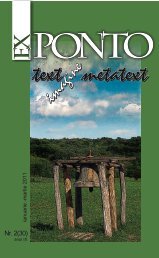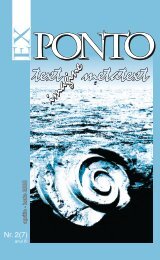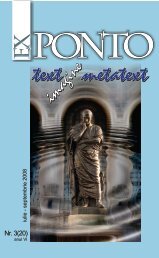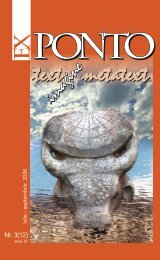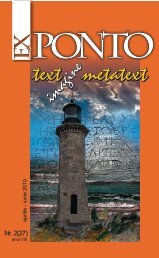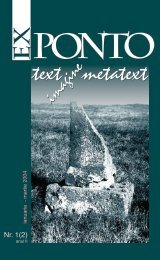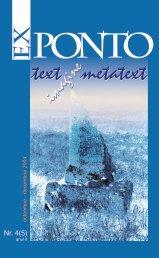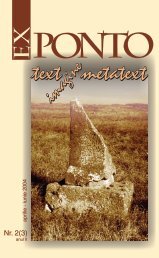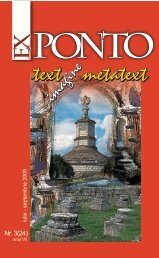Nr. 3 (32) anul IX / iulie-septembrie 2011 - ROMDIDAC
Nr. 3 (32) anul IX / iulie-septembrie 2011 - ROMDIDAC
Nr. 3 (32) anul IX / iulie-septembrie 2011 - ROMDIDAC
You also want an ePaper? Increase the reach of your titles
YUMPU automatically turns print PDFs into web optimized ePapers that Google loves.
literatura universală<br />
NICOLETA STANCA<br />
Lugh and Marconi against<br />
De Valera's constitution: female challenges in<br />
Brian Friel's Dancing at Lughnasa<br />
The essay aims at discussing Brian Friel’s play Dancing at Lughnasa as an<br />
illustration of feminine challenges of conservative Irish Catholic values in the<br />
1930s. There is a focus on analyzing dancing, music and storytelling as non-verbal<br />
modes of creating a special female bonding and as a means of social defiance in the<br />
confrontation with the oppressive principles of patriarchal Ireland in the 1930s. Brian’s<br />
play is seen as concerned with a microcosm, represented by the lives of the Mundy<br />
sisters and brother. On the one hand, the family will be seen as dominated by a sense<br />
of some missing or lost dimension; on the other hand, we will draw attention to the<br />
music, dances, laughter, jokes and sense of fun permeating the play. A motif that will<br />
be closely investigated is that of exile or homecoming, depicted through Father Jack’s<br />
story. The essay will also attempt to show the similarity between the rituals associated<br />
in Ireland with the festival of Lughnasa, the Mundy sisters’ dancing on the Irish tune and<br />
the African dances that Father Jack remembers in order to prove the deep humanity<br />
of all these manifestations.<br />
Keywords: Irishness, memory, homecoming, exile, storeytelling, dancing, rituals,<br />
patriarchy, defiance, womanhood<br />
D<br />
Ex Ponto nr. 3, <strong>2011</strong><br />
172<br />
ancing at Lughnasa, first produced in 1990 at the Abbey Theatre, is a ritual<br />
drama in which the ancient pagan Irish festival of music and dance, the<br />
Lughnasa, is reflected in the lives of the five unmarried sisters and the<br />
unreliable and unstable men in their lives. The focus of the play is on the<br />
difficulties these women have to face to realize themselves in a rigid patriarchal<br />
Catholic society. The primary theme may be considered the relationship<br />
between the sisters, the female bonding that they have built, to which we<br />
may subsume an interest in male-female relationships as well. Basically, “the<br />
Mundy women face Ballybeg’s patriarchal world together” (Lojek 80).<br />
Like many of Friel’s plays, it is set in Baile Beag (Ballybeg, in English) “a<br />
remote part of Donegal” and, as Seamus Deane notes, in “that borderland<br />
of Derry, Donegal and Tyrone in which a largely Catholic community leads a<br />
reduced existence under the pressure of political and economic oppression”<br />
(qtd. in Andrews 2). This imaginary place functions like Faulkner’s created<br />
Yoknapatawpha County, Missisippi, in which he set many of his dark stories.




